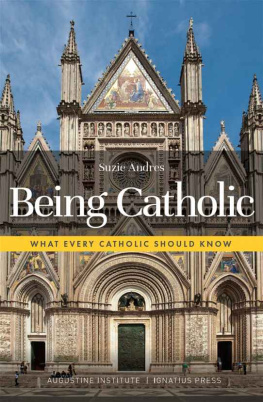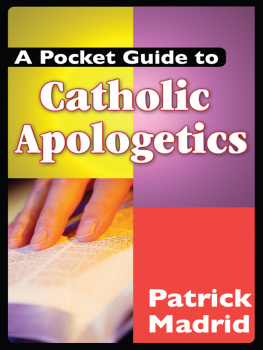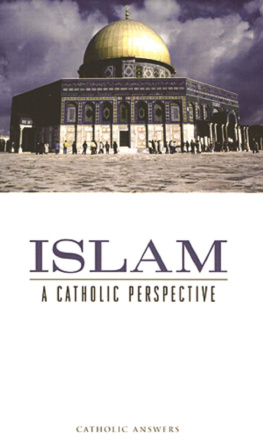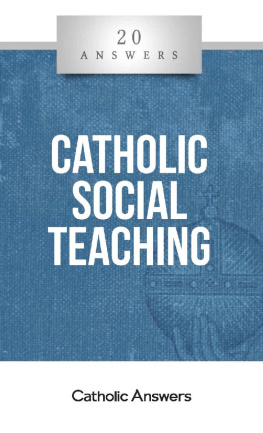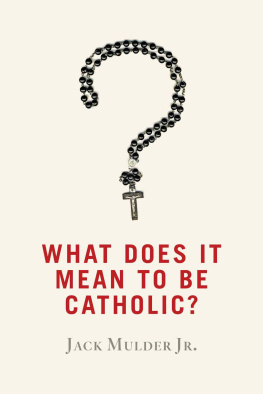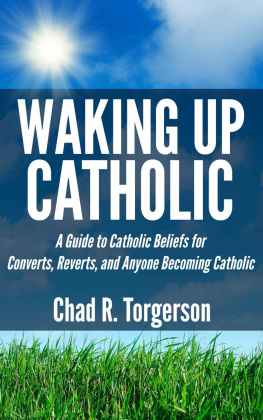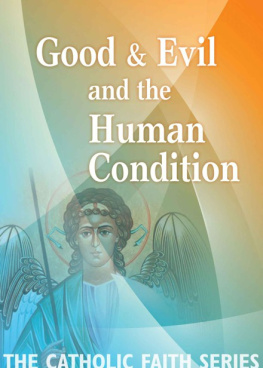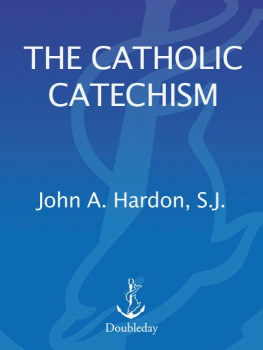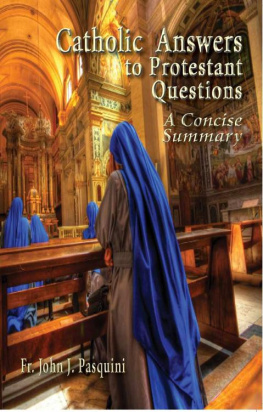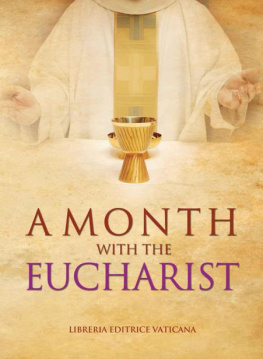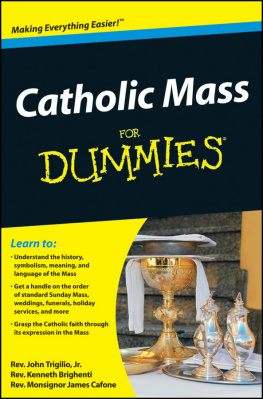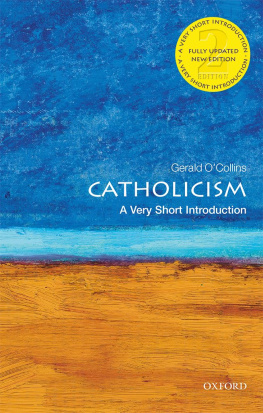Being Catholic
WHAT EVERY CATHOLIC SHOULD KNOW
Being Catholic
WHAT EVERY CATHOLIC SHOULD KNOW
Suzie Andres
IGNATIUS PRESS AUGUSTINE INSTITUTE
San Francisco Greenwood Village, CO
Excerpts from the English translation of the Catechism of the Catholic Church , Second Edition, 1994, 1997, 2000 by Libreria Editrice VaticanaUnited States Catholic Conference, Washington, D.C. All rights reserved.
Scripture quotations are from the The ESV Catholic Edition Bible, copyright 2017 by Crossway. Used by permission. All rights reserved.
Cover Design: Davin Carlson
2020 Ignatius Press, San Francisco,
and the Augustine Institute, Greenwood Village, CO
All rights reserved
ISBN 978-1-7338598-9-9 (pbk)
ISBN 978-1-950939-16-9 (hbk)
ISBN 978-1-64229-156-8 (eBook)
Library of Congress Control Number 2020943394
Printed in Canada
For Sanjay
O how glorious our Faith is!
Instead of restricting hearts, as the world fancies,
It uplifts them and enlarges their capacity to love .
St. Thrse of Lisieux
Contents
Introduction
On What You Will Find Herein
I have heard it said that G. K. Chesterton and Hilaire Belloc used to argue about whether it was better to be a convert, one who had chosen the Faith and could deeply appreciate it after years without the life-giving water and fullness of Truth, or to be a cradle Catholic who had the advantage of loving the Good, the True, and the Beautiful from infancy. Happily, many in our day have the blessing of both experiences.
I, for one, was baptized a month after I was born, but though sent to Catholic grade school and high school, I managed to graduate from both without much of a clue regarding the truths of the Catholic Faith. I had grown up loving the Blessed Virgin Mary as my Mother, for instance, but it was only when I went to an authentically Catholic college that I discovered what it is that makes Mary so special and what it is that elevates the Church (of which she is the exemplar) above all other churches.
Having had this experience of being both a cradle Catholic and a kind of convert to my own religion, Im thrilled to hand on to you in the following pages not only what I have received but also what I have looked up, what I have discovered after some embarrassingly ignorant and occasionally awkward moments, and what I have learned through more than fifty years of Catholic living, thirty-five of which have been very intentional.
You might wonder why.
Why, I mean, should I write this book, and why should you read it rather than simply look up this stuff yourself? No doubt you have the wisdom of the Internet at your fingertipsbut, in fact, thats precisely why I have written this book. Much as I appreciate the wide-ranging and often quite accurate information available from the screens at my disposal, there is more to what every Catholic should know than what you will find even in the Catechism of the Catholic Church , let alone on Wikipedia.
Whether you are a Cradle Catholic, Convert, or Curious Inquirer, when reviewing What Every Catholic Should Know , you will quickly find there are more Catholic customs, traditions, habits, and points of etiquette than there are articles of the Creed. So, for easier access, my bet is that you will find it handy to have all this lore in one fifty-thousand-word document, divided into chapters, preprinted, and boundyou know, in a book.
Historically, books of what every Catholic should know are called catechisms, named for the question-and-answer method and including a traditional fourfold progression of The Creed (What Catholics Believe), The Commandments (What Catholics Do, often thought of as What Catholics Dont Do, but frequently supplemented by the Beatitudes to lend a positive, New Testament, can-do note), and The Sacraments and Prayer (a two-part answer to the question, How in the world can Catholics live this way?).
Since Pope St. John Paul II gave us, among his many other gifts, a universal catechism called, fittingly, Catechism of the Catholic Church , we dont need to worry about providing in this slim volume the entire panoply of Catholic beliefs.
In addition to the Catechism , I recommend to readers the new Code of Canon Law (promulgated, again by John Paul II, in 1983) as a very handy reference book for what Catholics can and cant do.
These two important books, along with the Holy Bible, will give you more than a lifetimes worth of material to study in order to know what Catholics believe and do. Here in this book, then, we wont duplicate all you will find there, but rather focus on those Catholic customs, traditions, and practices that are in danger of being forgotten but that have been, for centuries, the joy of Catholics to remember.
Take the Catholics in Japan around the mid-nineteenth century. They had been living undergroundno, not literally, but they had to hide the practice of their Catholic Faithfor nearly two hundred years, since Christianity had been banned along with all foreigners in 1638. That was only ninety years after St. Francis Xavier had brought the Gospel to Japan and, with his fellow early Jesuits and the missionaries who followed, succeeded in building up the flock to three hundred thousandenough to prompt persecution, martyrdom, and the general prohibition of Christianity.
Did the Japanese Catholics lose their faith? Did the Church in Japan die? No one in the West knew because missionary priests who tried to enter the country from 1638 to 1853 (when Japan was finally reopened to the West) did not live to tell about what they found in Japan. They, too, were martyred.
The answers came on March 17, 1865. That was the day Fr. Bernard Petitjean, priest of the Paris Foreign Mission Society, while standing near the altar in the beautiful, newly built Oura Church in Nagasaki, was tapped on the shoulder by a Japanese woman. When he turned, she greeted him saying, We have the same heart as you.
We were the hidden Japanese Catholics, the Kirishitan, whom she represented. These Kirishitan (from the Portuguese cristao ) had been watching the priests, wondering if they were the successors to the ancient Fathers who had brought the Faith to Japan centuries before. The Japanese Catholics had a litmus test: Were the priests in communion with the pontiff in Rome? Did they honor the image of the Virgin Mary? Did they live in celibacy?
A small group had approached Fr. Petitjean as he made his rounds of the city in his priestly garb, hoping as he did so to attract interested Japanese. He took them to the church to tell them something of the Faith. He made an act of reverence at the main altar after they had entered the church, and thats when he received the tap on the shoulder. Imagine his surprise at the womans news.
We have the same heart as you.
On behalf of the group, she asked insistently to see St. Mariasama. When Fr. Petitjean showed her the altar of Our Lady, the woman saw the infant Jesus in His mothers arms and said it was Jesussama. She then told the priest there were thirteen hundred underground Catholics in the area and they had retained the customs from the ancient Fathers. A few days ago, we entered the sad season. (This was Lent.) We celebrate the birth of Jesussama on the twenty-fifth of the cold month.
They had not had the Eucharist for more than two hundred years, for they had not had a priest during those two long centuries. But they had kept the rite of Baptism, they had kept the seasons of the liturgical year, and they had kept their Saviors mother as their own according to His words from the Cross: Behold your mother.
The woman was a midwife named Elizabeth Tsuruthey had kept the custom of Christian names. They had lived in persecution and isolation, receiving and passing on the religion and faith of their forebears since the time of St. Francis Xaviers mission in 1549.

